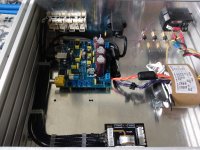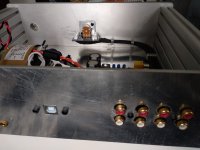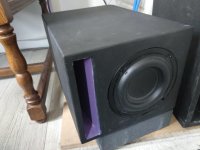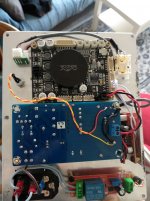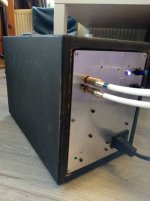I am nearing the end of my journey to build a 100% DIY system. It's all done on a budget since I am a student who does not qualify for a student loan 🙂
When I connect my active subwoofer (100w Wondom amp and NE5532 preamp) together with my power amp (2x 250w L25D, no preamp) to my DAC (CS8416 + CS4398 USB to pc) I get loss of audio quality at the speakers after I switch on the sub. When I turn the sub off again this quality loss remains. only when I disconnect the RCA's from the sub amp plate the sound opens up again.
It's hard to describe but the audio sounds a bit muffled and dull. It's not because of sound wave cancellation with the sub because it does not matter if I turn the sub down or switch it off after it's been powered on, the degrade in audio quality from the speakers remains.
My DAC (work in progres) has it's output split into 4 sets RCA. Now I know I can add some sort of preamp buffer before the power amp, but the 250w/ch from the L25D modules is overkill enough. I have to turn the volume down in Foobar AND at the volume potentiometer between the DAC and the amp.
I am not looking for more output power. But I do wish to solve this loss of quality caused by adding the subwoofer to the system
What could cause this loss of quality?
I know to pot I'm currently using in the DAC is a cheap and crappy one, used just for testing until I find a better one. But there are no audio problems when the sub is not connected.
What can I do to fix this?
I've attached some pics from the DAC and how I have split the output
When I connect my active subwoofer (100w Wondom amp and NE5532 preamp) together with my power amp (2x 250w L25D, no preamp) to my DAC (CS8416 + CS4398 USB to pc) I get loss of audio quality at the speakers after I switch on the sub. When I turn the sub off again this quality loss remains. only when I disconnect the RCA's from the sub amp plate the sound opens up again.
It's hard to describe but the audio sounds a bit muffled and dull. It's not because of sound wave cancellation with the sub because it does not matter if I turn the sub down or switch it off after it's been powered on, the degrade in audio quality from the speakers remains.
My DAC (work in progres) has it's output split into 4 sets RCA. Now I know I can add some sort of preamp buffer before the power amp, but the 250w/ch from the L25D modules is overkill enough. I have to turn the volume down in Foobar AND at the volume potentiometer between the DAC and the amp.
I am not looking for more output power. But I do wish to solve this loss of quality caused by adding the subwoofer to the system
What could cause this loss of quality?
I know to pot I'm currently using in the DAC is a cheap and crappy one, used just for testing until I find a better one. But there are no audio problems when the sub is not connected.
What can I do to fix this?
I've attached some pics from the DAC and how I have split the output
Attachments
The description of "loss of quality" is still to vague. You should do some basic measurements. There is plenty of free software with which to do a basic frequency response measurement. Room EQ Wizard, for example. Using the Pink Noise generator and the RTA function in 1/3 octave, and measuring at your main amp output through a pad, you should readily see the response change, if that's what's going on. REW will also do distortion measurements.When I connect my active subwoofer (100w Wondom amp and NE5532 preamp) together with my power amp (2x 250w L25D, no preamp) to my DAC (CS8416 + CS4398 USB to pc) I get loss of audio quality at the speakers after I switch on the sub. When I turn the sub off again this quality loss remains. only when I disconnect the RCA's from the sub amp plate the sound opens up again.
It's hard to describe but the audio sounds a bit muffled and dull. It's not because of sound wave cancellation with the sub because it does not matter if I turn the sub down or switch it off after it's been powered on, the degrade in audio quality from the speakers remains.
Quantifying the change is the first step in determining the cause.
How is the split done? DAC output through a resistor to each jack, or just 4 jacks connected together?My DAC (work in progres) has it's output split into 4 sets RCA.
A buffer is a unity gain amplifier. You will not increase volume with a buffer, you will isolate the loads on the output of the DAC. Passing the output through a resistor to each load (jack) will do something similar, just not quite as well.Now I know I can add some sort of preamp buffer before the power amp, but the 250w/ch from the L25D modules is overkill enough. I have to turn the volume down in Foobar AND at the volume potentiometer between the DAC and the amp.
You should also look carefully at the DAC output. You've specified the CS4298, which has an output impedance of 118 ohms, but a minimum load of 1K. That's not really a good output characteristic to drive much of a load. That's where a buffer amp, or better, one for each output jack, would help.
Again, a buffer amp is unity gain. No more output voltage, just output isolation and load drive.I am not looking for more output power. But I do wish to solve this loss of quality caused by adding the subwoofer to the system
Without a schematic, I couldn't make more suggestions.What could cause this loss of quality?
I know to pot I'm currently using in the DAC is a cheap and crappy one, used just for testing until I find a better one. But there are no audio problems when the sub is not connected.
"an impedance mismatch" implies what you want is an "impedance match", which is not technically true. In audio, output impedances are very low compared to input impedances. This means an output should be able to drive any input because there's no match, just an output driver and a very light load. Even two or three loads should not pose a problem. But there's never a match of output impedance to input impedance.Probably an impedance mismatch. Add a buffer.
My suspicion is he hasn't provided a real output driver though, or the sub input presents too much load because of a defect in design or error in connection. Either buffered outputs or build-out resistors would solve the problem, assuming there's no issue with the sub input.
Measurements, guys!
Often the cheap stereo to mono filter in the sub causes the problem mentioned. Buy another sub and running mono to each sub fill fix your problem. Or buy a buffer.
My guess is its caused by the AC ground loop introduced by connecting in the sub. A couple of cheap isolation transformers between sub and DAC might well help. Re-routing the DAC ground wiring might well help too, you want the 0V feed direct from the trafo rather than via the DAC PCB.
I guess I should state that I still don't understand much of the theory behind amplifiers yet. I know the core concepts, and know the basics of electronnics.
I made the amps and the dac from kits and modules. But I am willing to expand my knowledge. I find however that much information I read on this site is communicated between experts, and sometimes difficult for me to underrstand.
I will look into measuring with REW.
I have connected a 50K log pot using shielded twisted solid core wires directly to the DAC output, and from there to the 4 pairs of RCA sockets with no resistors in between.
What is the correct placement and value for these resistors? Each socket positive and negative need their own resistor?
Also if someone can point me in the direction of a simple and affordable buffer circuit, that'd be great too. I see a lot of tube buffers/preamp modules on aliexpress, but I never know if they are decent or if they contain design flaws or underspec'd components
I made the amps and the dac from kits and modules. But I am willing to expand my knowledge. I find however that much information I read on this site is communicated between experts, and sometimes difficult for me to underrstand.
I will look into measuring with REW.
I have connected a 50K log pot using shielded twisted solid core wires directly to the DAC output, and from there to the 4 pairs of RCA sockets with no resistors in between.
What is the correct placement and value for these resistors? Each socket positive and negative need their own resistor?
Also if someone can point me in the direction of a simple and affordable buffer circuit, that'd be great too. I see a lot of tube buffers/preamp modules on aliexpress, but I never know if they are decent or if they contain design flaws or underspec'd components
My guess is its caused by the AC ground loop introduced by connecting in the sub. A couple of cheap isolation transformers between sub and DAC might well help. Re-routing the DAC ground wiring might well help too, you want the 0V feed direct from the trafo rather than via the DAC PCB.
So I should connect a wire from the DAC 0v to the grounding point on the chassis where the safety ground from the transformer is connected?
The pot and it's cables are getting replaced by a decent 50k audio pot I just bought today at my local electronics parts shop. I plan on making an extension shaft. I take it that it's important to keep the signal wires as short as possible?Could be it is trying to drive all those long screened cables is getting too much.
I made those wires by twisting 2 CAT5 solid core wires and adding a shielded sleeve. the shielded sleeve is connected to the negative wire in the twist on both ends. on top of that is a pet sleeve for isolation
So I should connect a wire from the DAC 0v to the grounding point on the chassis where the safety ground from the transformer is connected?
The sockets for output from your DAC should have their 0V connection direct to the 'star earth' where transformer 0V and safety ground are connected. If this 0V goes to the PCB instead then noise currents (from your sub) will flow in places which will upset the sound quality.
Incidentally if I understand correctly you're using a 50k pot as a volume control between the DAC board and your output RCAs? That will have too high an output impedance to drive cables well. Really it would need to be at most a 10k pot and then the cables should be shorter than 1m. Or use the 50k pot but add a buffer after it.
Last edited:
The sockets for output from your DAC should have their 0V connection direct to the 'star earth' where transformer 0V and safety ground are connected. If this 0V goes to the PCB instead then noise currents (from your sub) will flow in places which will upset the sound quality.
Incidentally if I understand correctly you're using a 50k pot as a volume control between the DAC board and your output RCAs? That will have too high an output impedance to drive cables well. Really it would need to be at most a 10k pot and then the cables should be shorter than 1m. Or use the 50k pot but add a buffer after it.
So the negative left and negative right connection, which are also connected to the cable shield right now, can go straight to star ground.
I must say this DAC is dead quiet. No hum or hiss at all.
What is the 10k value based on? A factor 10 of the minimum load of the DAC?
The 10k value is just a kind of 'rule of thumb' - but its based on the RC time constant of the source impedance (worst case 2.5kohm with 10k pot) plus a guesstimate of the capacitance of a typical cable (say 250pF) plus the input capacitance of a typical amp (say that's another 250pF). Together these give a -3dB point around 120kHz - hence a slight amount of loss at 20kHz but maybe not enough to notice.
This will have problems. The 50K pot should be more like 10K, and in this application, that's still a compromise. If your pot is a master volume control, it needs a buffer after it to drive all the loads on those RCA jacks.I guess I should state that I still don't understand much of the theory behind amplifiers yet. I know the core concepts, and know the basics of electronnics.
I made the amps and the dac from kits and modules. But I am willing to expand my knowledge. I find however that much information I read on this site is communicated between experts, and sometimes difficult for me to underrstand.
I will look into measuring with REW.
I have connected a 50K log pot using shielded twisted solid core wires directly to the DAC output, and from there to the 4 pairs of RCA sockets with no resistors in between.
Isn't there volume control capability in the DAC?
The resistors don't apply if your'e using a 50K pot to feed the jacks.What is the correct placement and value for these resistors? Each socket positive and negative need their own resistor?
Also, you've mentioned the DAC chip, but it's on a pre-built board, right? Which one?
Also if someone can point me in the direction of a simple and affordable buffer circuit, that'd be great too. I see a lot of tube buffers/preamp modules on aliexpress, but I never know if they are decent or if they contain design flaws or underspec'd components
Can you solder? If you could, you can make your own for next to nothing. A simple unity gain buffer only takes one opamp, and is possibly the most innocuous of opamp circuits ever. If you can't solder, and don't want to learn (pretty useful skill for any DIY'er), you might find an opamp buffer board online, but the ones I've just seen lack documentation, so hard to recommend anything.
With a buffer after the pot you don't need to change the pot value. The buffer will still need build-out resistors between its outputs and each RCA jack. 1K is fine.
Do not consider a tube buffer.
Last edited:
Something like this might work. Not much documentation, but it looks like a unity gain stereo buffer with a DC offset trim.
Https://www.aliexpress.com/i/32927722398.html
You would still need a 1K resistor between the output and each jack.
Https://www.aliexpress.com/i/32927722398.html
You would still need a 1K resistor between the output and each jack.
Another option is to drive the sub from the power amp output through an attenuator (100K & 10K values come to mind). Worked in my rig.
Also...subs require a L+R sum. So with the buffer you can also take a resistor from each buffer output and tie them together at the jack that will feed the sub.
This will have problems. The 50K pot should be more like 10K, and in this application, that's still a compromise. If your pot is a master volume control, it needs a buffer after it to drive all the loads on those RCA jacks.
Isn't there volume control capability in the DAC?
The resistors don't apply if your'e using a 50K pot to feed the jacks.
Also, you've mentioned the DAC chip, but it's on a pre-built board, right? Which one?
Can you solder? If you could, you can make your own for next to nothing. A simple unity gain buffer only takes one opamp, and is possibly the most innocuous of opamp circuits ever. If you can't solder, and don't want to learn (pretty useful skill for any DIY'er), you might find an opamp buffer board online, but the ones I've just seen lack documentation, so hard to recommend anything.
With a buffer after the pot you don't need to change the pot value. The buffer will still need build-out resistors between its outputs and each RCA jack. 1K is fine.
Do not consider a tube buffer.
Thanks for the information.
This is the link do the DAC
aliexpress.com/item/1251297849.html
I got it as a kit, so yes soldering is no problem
So a 1k resistor on every output RCA signal + and -? Or only on the + side?
And no I wouldn't prefer a cheap tube buffer. The ones from China seem a bit to gimmicky for me.
Last edited:
Thanks for the information.
This is the link do the DAC
aliexpress.com/item/1251297849.html
I got it as a kit, so yes soldering is no problem
So a 1k resistor on every output RCA signal + and -? Or only on the + side?
On an unbalanced RCA connector, the signal exists only on the inner contact, (I think you're calling that +, that's not really what it is). The outer contact is grounded. So one resistor to each output jack, connected to the inner contact, +.
Note my comment about the sub jack...
On an unbalanced RCA connector, the signal exists only on the inner contact, (I think you're calling that +, that's not really what it is). The outer contact is grounded. So one resistor to each output jack, connected to the inner contact, +.
Note my comment about the sub jack...
Thanks for the clarification. Everything makes a lot more sense now.
I've hooked up a 10k pot instead of 50k, and this makes a world of difference.
It's almost like I have a brand new pair of speakers! There is so much more clarity and detail than with the tiny 5v DAC I used up to this point.
The L25D amp runs cooler then even before too.
Still no Windows volume control though, but I've read that windows volume control messes up the bitrate anyway.
I have plenty of room in the enclosure so I will definetly look into that buffer.
The subwoofer amp is a Wondom/Sure board with build in dsp. It takes 2 channels and does de mixing to mono. I don't imagine it makes much sense to run them through some resistors and sum them, just to split them into 2 mono channels before connecting to the amp
WONDOM | STORE
Attachments
- Home
- Source & Line
- Analog Line Level
- quality loss when connecting multiple amplifiers to one source
